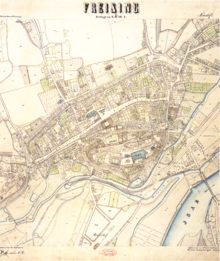Freising old town
The old town of Freising , together with the Domberg, forms the historical center of Freising . It extends in a west-east direction over a length of around 960 meters, north and west of Toompea. The main road represents the main traffic artery, which - according to the direction of flow of the Isar and brooks - is called Obere Hauptstraße in the west and Untere Hauptstraße in the east . Marienplatz divides these two areas in the middle .
history
While the Domberg was officially confirmed as the bishop's seat in 739 AD, in the 9th and 10th centuries the civil town at the foot of the Domberg gradually emerged as a suburbium , first the area around the St. George Church called Mitterfreising , later also deeper, swampy areas. Due to the great fire on Palm Sunday 1159, Toompea and the city were largely destroyed and then rebuilt. This floor plan from 1159 has largely been preserved to this day.
The Domberg was the spiritual, cultural and manorial center. With the granting of market, customs and minting rights to the Freising Bishop in 996, a regular market was set up, which is still in the old town as a weekly market on Wednesdays and Saturdays on Marienplatz consists.
In the late Middle Ages, the city of Freising as a bishopric was called the “prince-bishop's capital and residence city” until the secularization in Bavaria in 1802/03. The old town was originally limited by city walls and the city gates, which were demolished in the 19th century: (clockwise, starting from the south, these were) "Münchner Tor" (Bahnhofstrasse), "Münchner Thörl" (Am Wörth), " Veitstor ”(Obere Hauptstrasse, 100 m west of it was the parish church of St. Veit, today Lindenkeller),“ Brick Gate ”(Ziegelgasse),“ Murntor ”- also called“ Landshuter Tor ”- (General-von-Nagel-Strasse) and that "Isartor" (Heiliggeistgasse). Only the Karlsturm, the Bürgerturm and the two cathedral gates have been preserved as the last remnants of the old Freising town fortifications .
After the Second World War
During the Second World War, the old town of Freising was largely spared. In a bombing by Allied aircraft on April 18, 1945, the area around the station was largely destroyed, in the old town parts of Bahnhofstrasse and Kochbäckergasse. However, several buildings were demolished and new buildings were built after the war. Today, almost all the style epochs since the late Middle Ages have been preserved in the old town: Gothic buildings, a few Renaissance buildings, numerous Baroque buildings, as well as Rococo, Classicism and Historicism, some new buildings since the 1950s. However, many historic houses are often not recognizable as such, as they were repeatedly adapted to the prevailing taste of the time, and often still contain building fabric from the Middle Ages at their core.
Today there are still a large number of listed buildings in the Freising old town. The center consists of numerous commercial buildings, public institutions and offices as well as residential buildings. For years, the city of Freising, associations and civic engagement have been trying to preserve and enhance the historic city center.

